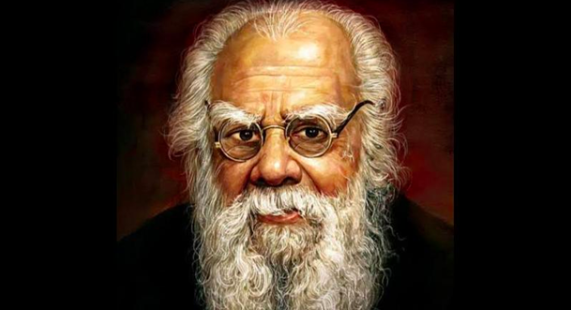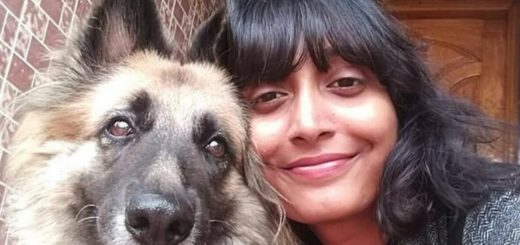Tamil Pride, iconoclast, PERIYAR! Periyar, face of caste equality & Dravidian Pride, turns 141 today.

Draksha Sharma, in The Asian Age, Sep. 17, 2019
Periyar was not only the face of caste reforms in India, but also a symbol of Tamil pride. Periyar's philosophy and action revolved around his opposition to Brahminism and gave birth to the ideology of present day parties DMK, AIADMK and MDMK. (Photo: Twitter)
Venkatappa Ramasamy born in 1879 to Venkata Naicker and Chinnathayee in Erode in modern-day Tamil Nadu is known today by many unforgettable titles like: iconoclast, rationalist, social reformer, Anti-Brahminist, Father of Dravidian movement, and finally popularly known as Periyar Thanthai or PERIYAR.
This piece is published because of the person’s many striking relevance to both religion and politics today. In religion, he was an avowed atheist; in politics he advocated freedom and independence for Tamil culture and language. He was totally especially against imposition of Hindi, now rearing its ugly head. He was also for equality for women with men (50% reservation for women) That kind of equality is unthinkable even in the Catholic Church.
Lessons to Learn!
Now, what are the lessons we today should learn from him? Some people are famous and notorious at once. We should imitate him for those qualities which rationally speaking, made him famous and unforgettable and avoid those which made him notorious.
His positive points were his advocacy for gender equality, fighting for 50% reservation for women, opposing imposition of Hindi on Tamilians, when Constitution has given 22 languages equal status, his fight against Brahmin domination and caste system, belief and practice of religious (Hindu) mythological teachings, his work for the low castes, support for widow-marriage, opposition to child marriage, Cennai women’s confence conferming him with the PERIYAR.
Questionable itemss
Yet he was reported to have married, when too old a very young girl brought up like a daughter, which was frowned upon by general public. His denial of the existence of God, efforts to destroy all religions are only questionable issues.
Read closely and draw your own conclusions to act for or against so many unseen things happening both in Religion and Politics. james Kottoor, editor CCV.
Please read below Draksha Sharma’s Article in Asian Age
Mumbai: On Tuesday, hastag 'HBDPERIYAR141' was among the top trending hashtags in India.The hashtag was used to wish happy birthday to Periyar, the pioneer of Dravidian Nationalism.
Periyar's philosophy and action revolved around his opposition to Brahminism and gave birth to ideology of present day parties– DMK, AIADMK, MDMK.
At his birth anniversary, a look at the legacy of an iconoclast, rationalist social reformer, crusader of anti-Brahminism and father of Dravidian movement–Erode Venkatappa Ramasamy, popularly known as Periyar Thanthai or Periyar.
"There is no god, there is no god, there is no god at all. He who invented god is a fool. He who propagates god is a scoundrel. He who worships god is a barbarian.''
E V Ramasamy Periyar
Early years
In 1879, EV Ramasamy was born to Venkata Naicker and Chinnathayee in Erode in the erstwhile Madras Presidency and modern-day Tamil Nadu. His parents belonged to a merchant caste– balija– in Andhra Pradesh.
He belonged to an affluent trading family and at an early age he dropped out from primary school to join his father's business. He used to listen to several religious guru, who came to his house to teach Shastras. Ramasamy, however, was critical of these teachings and started to question apparent contradictions in Hindu mythological teachings.
At the age of 19 he got married to a 13-year-old girl, Nagammai.An incident in 1904 turn Periyar heavily against the caste system in India. At the holiest city for Hindus– Varanasi, he was turned out of an eatery because he was not a Brahmin. He was once again stopped to enter as he was wearing mouustache — something Brahmins back then rarely used to keep.The pilgrimage taught him that hinduism was nothing but Brahmical domination and exploitation.
Politics
In 1919, the reformer joined the Congress under the influence of his close friend C Rajagopalachari (Rajaji). Later, he was appointed as the president of the Madras Presidency Congress Committee in 1922. Ramasamy, however, soon left as his efforts to get reservations in education and government jobs were defeated within his party during the Tirupur session.
Texts on his life note suggest he observed that Congress was working in Brahminical interests and hence decided to resign. During his initial days in Congress he held various key positions in the Erode municipality. He rigorously fought for issues related to khadi, liquor prohibition and abolition of untouchability. For participating in non-cooperation movement he was jailed.
His work for the upliftment of the lower-caste Keralites in 1924-25 during the Vaikom Satyagrah gave him the moniker "Vaikom Veeran".
In Vaikom, a town of the erstwhile Travancore kingdom, lower-caste people were not allowed to even go near the temple. He fiercly led the movement which left a marking impression on his ideas and political life.In 1925, Periyar dived into radical, on-ground politics with a trade union movement in Nagapatinam. It was this occassion where he happened to meet the pioneer of communist ideology– Singaravelan. Around this time, he started the notable, Slef-Respect Movement– also referred to as the Dravidian movement.
He went on to join the Justice party and was elected the party president in the late 1930s. He renamed it the Dravidar Kazhagam (DK) in 1944.Ramasamy was also against the Hindi imposition. When C Rajagopalachari, India's last Governor-General, made Hindi compulsory in all government schools in 1937, as the chief minister of Madras Presidency, Ramasamy launched a protest aginst the move.
He gave the popular slogan "Tamil Nadu for Tamilians". His ideas and crucial involvement in the Justice party changed his political identity forever. He later came to known as Periyar meaning 'respected one' or 'elder'.In 1950, he declared his party's vision. He wanted to build a platform for bringing the social and religious reform through the Dravida Kazhagam.
“The final agenda of this party is to destroy all religion,” he said.When Muslim League demanded for Pakistan, Perriyar demanded for a seperate Tamil country.In fact, when the whole nation was celbrating freedom from the dcades of british rule, Perriyar recognised country’s first Independence Day as a day of sorrow.
His party never entered the electoral politics. His protege, CN Annadurai, however wanted to contest election. The dissent forced Annadurai to left the party and start his own Dravida Munnetra Kazhagam in 1449.To desseminate his ideas of social justice and self-respect, Periyar also founded a newspaper– Kudi Arasu. This became Periyarr's full-time job untill his death at the age of 97.
A-Radical-Femenist
Periyar was a staunch believer of gender equality. He fought for the progress of women and questioned the gender inequality prevelant in the society. He fought against barbaric social customs which were unfair to woman, such as child marriage and widow remarriage. He encouraged women to actively take part in social movements and politics.
Periyari tirelessly worked for women education and raised the issue of 50 per cent reservation for women in all the sectors. It was the women's conference in Chennai in 1938 that conferred him with the title of 'Periyar'.
Periyar is not only a symbol of caste reforms in India, but also of the Tamil pride. His political ideas continues to hold significance in the contemporary politics in Tamil Nadu and remains inspire DMK and AIADMK.
















